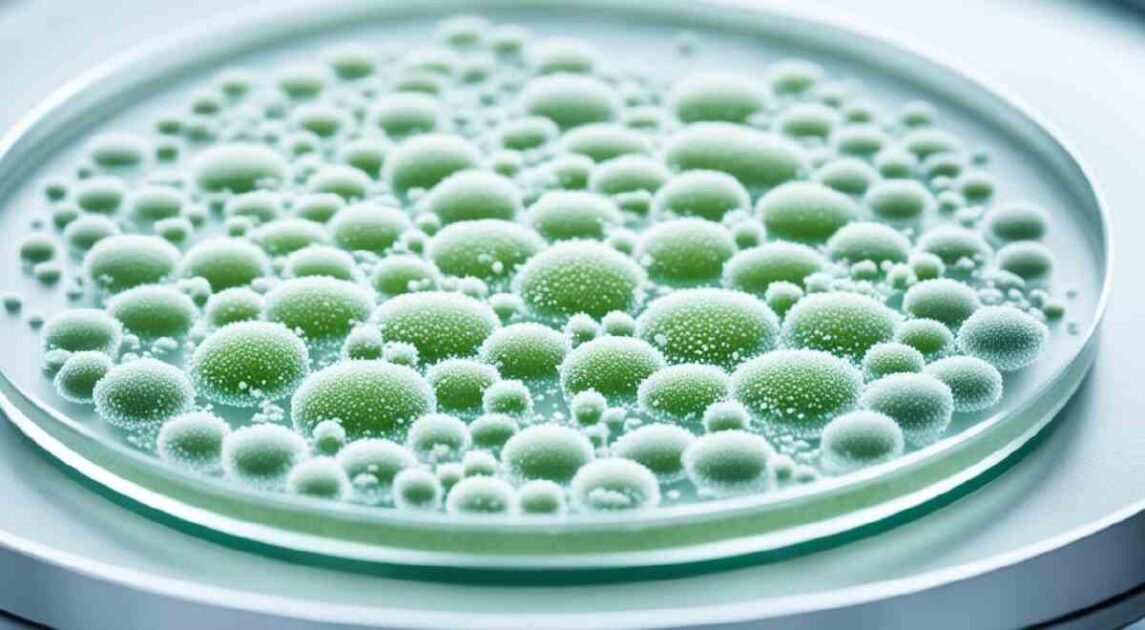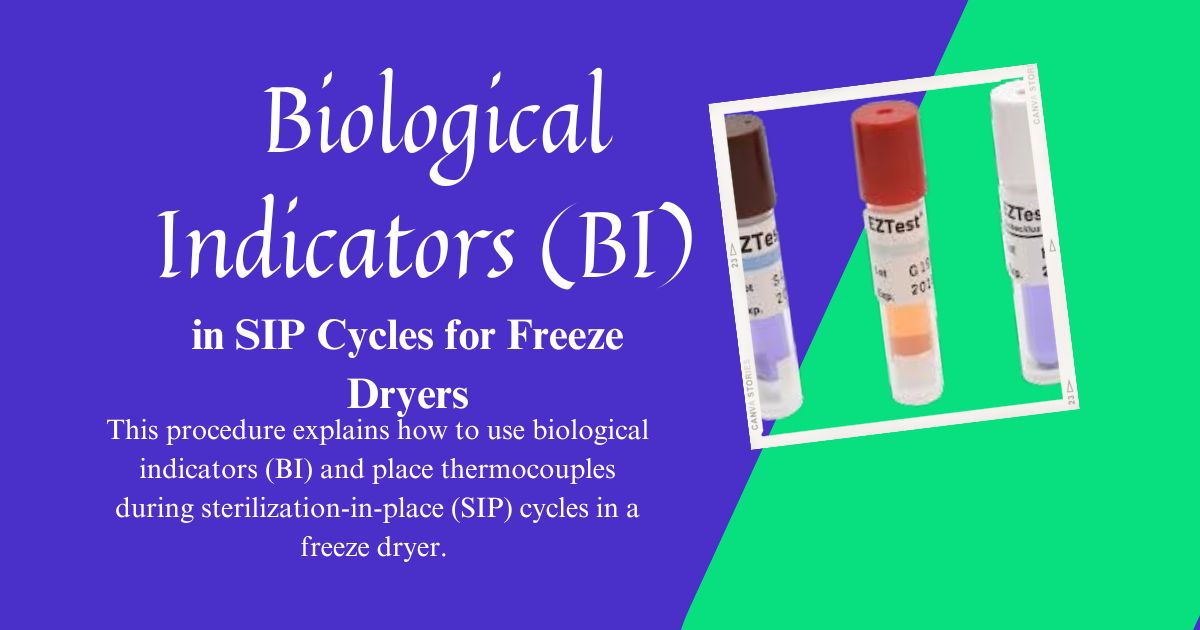Comprehensive Guide to Using Biological Indicators (BI) and Thermocouple Placement in Sterilization-In-Place (SIP) Cycles for Freeze Dryers
This procedure explains how to use Biological Indicators (BI) and place thermocouples during Sterilization-In-Place (SIP) cycles in a freeze dryer. The goal is to ensure the sterilization process is effective. It covers the steps for running a SIP cycle, handling BI samples, and placing thermocouples correctly to get accurate temperature readings. It also includes precautions to prevent errors and actions to take if issues arise during validation.
This document provides detailed instructions on conducting SIP runs, handling and submitting BI samples, and placing thermocouples correctly. Additionally, it outlines the precautions to be taken to prevent data inaccuracies, the steps to handle nonconformance of thermocouple data, and the corrective actions required in case of any issues during the validation process. By adhering to these procedures, the integrity and reliability of the sterilization process can be maintained, ensuring the highest standards of quality control in the production environment.
Description:
This document outlines the procedure for conducting a Sterilization-In-Place (SIP) run to evaluate the effectiveness of sterilization in a freeze dryer. It details the use of thermocouples and biological indicators (BI) according to the study protocol. Post-run, the collected BI samples are submitted to Quality Control (QC) for analysis. The document includes guidelines on the placement of thermocouples to prevent false junctions and ensure accurate data collection, as well as precautions and corrective actions in case of thermocouple damage or nonconformance. The importance of power supply verification and clock synchronization is also emphasized.

Key Takeaways
- Biological indicators are vital for checking if SIP cycles for freeze dryers work well.
- They make sure the final products are clean and safe for patients.
- Using biological indicators correctly keeps vials safe and stops germs from getting in.
- Knowing about biological indicators is key for companies to follow the rules and meet standards.
- Adding biological indicators to the freeze-drying process is a big step in making top-quality, clean freeze-dried products.
Biological Indicators in SIP Cycles for Freeze Dryers
Using biological indicators is key to checking if SIP cycles for freeze dryers work well. This method, called cycle mapping, looks at how well the SIP cycle kills bacteria spores. It’s a way to make sure the sterilization process is effective.
Spore survival is crucial for SIP cycle success. By checking spore viability before and after the cycle, makers can see if they’ve met the sterilization goals. This is important for freeze-drying.
Parametric release is built on what cycle mapping shows. It lets manufacturers send out products after a successful SIP cycle, as shown by biological indicators. This method cuts down on time and resources needed for product release, keeping quality high.

Adding biological indicators to SIP cycles in freeze dryers is vital for product safety. By keeping an eye on and proving the cycle’s effectiveness, manufacturers can improve their cycle mapping and use parametric release. This leads to more efficient and trustworthy freeze-drying operations.
Important Points on Biological Indicators (BIs):
- Biological indicators (BIs) are test systems containing viable microorganisms with defined resistance to specific sterilization processes.
- BIs provide information on whether the necessary conditions were met to kill a specified number of microorganisms, ensuring confidence in the sterilization process.
- Endospores, or bacterial spores, are the primary microorganisms used in BIs due to their high resistance.
- Bacterial spores are selected based on their known resistance to specific sterilization processes.
Geobacillus stearothermophilus spores are commonly used in BIs for steam and vaporized hydrogen peroxide sterilization processes due to their high resistance.
Procedure for uses of BI and placement
Performed one SIP run to check the efficacy of the sterilization study in an empty chamber during the sterilization cycle with a thermocouple and BI (biological indicator) mentioned as per the study protocol in the freezer dryer.
After completion of the run, collect the BI and submit it to QC (quality control) micro within 4 hours. Attached is a BI test request along with BI report with qualification report
Precautions: Precautions are to be taken during thermocouple placement in freeze dryer to avoid creating false junction
- To prevent drawing condensate, slices or cuts should be made in outer protective layer of thermocouples
- During SIP cycle, the thermocouple should not touch the wall surface
- Before starting the periodic performance verification of freeze dryer, check the clock synchronization to be verified
- verification of the correct power supply to the validator.(assurance of online UPS, connection flow, requirement and verification of input voltage). Use spike buster with thermocouples.
- Before starting any activity of qualification, prepare the set-up report of the validator, check it, and after that, load the setup in the validator.
- In case of BI container damage, as a corrective action, perform CIP and SIP before performing repeat run
Handling of nonconformance of thermocouple data
Due to the sterilization and electronic nature of the thermocouple, there may be chances of thermocouple damage during validation or qualification. Hence, the nonconformance property of thermocouple needs to be conferred below:
- Physical damage: (if photographs are found to be attached) thermocouple damage may be due to a cut during handling at the time of qualification. Thermocouple damage, which is physical damage, must expose the internal wire to steam, other sterilization media, the machine chamber, or other parts. Due to this thermocouple may give irrelevant data. Then, even if the post-calibration of thermocouple passes, the concerned probe should be excluded. Because it may pass during post-calibration study as calibration is done in dry bath.
- During thermometric evaluation/study, there is a chance of thermocouple failure, which may be detected in formal function due to the following reasons, but not limited to:
- Thermocouple damage during handling at the time of qualification
- The thermocouple, which requires physical damage, must expose the internal wire to or minus sterilization media. Due to this thermocouple may give relevant data.
- Erratic behavior or result of probes, e.g., Hyphen (—-), Esoteric Mark (****), minus temperature (-), invalid data.
- Thermocouple displacement from the point of contact.
- Loss of contact with the validator or sensor input module.
- Thermocouple-erratic results due to power fluctuations
- In above these cases repeat run to be taken
There are a greater number of probes used than the minimum requirement for any validation, such as SIP and temperature mapping. A few sensors or probes may get damaged, as per the above reason stated at the bullet points. However, it will be ensured that none of the probes in critical locations damaged.
Conclusion
Ensuring the efficacy of the sterilization process in freeze dryers is crucial for maintaining product safety and quality in the pharmaceutical and biotechnology industries. By following the outlined procedures for using biological indicators (BI) and placing thermocouples, accurate validation of the lyophilization sterilization process can be achieved. Adhering to the precautions and handling nonconformances promptly ensures reliable data collection and minimizes the risk of errors. This comprehensive approach guarantees that the sterilization process meets regulatory standards and maintains high-quality control.
FAQs
What is the purpose of using biological indicators (BI) in the sterilization process?
Biological indicators are used to measure the effectiveness of the sterilization process by exposing resistant microorganisms to the sterilization conditions and checking if they are inactivated.
Why is thermocouple placement important in a freeze dryer?
Proper thermocouple placement is crucial to avoid false junctions and ensure accurate temperature readings, which are essential for validating the sterilization process.
What should be done if a thermocouple gets damaged during the sterilization cycle?
If a thermocouple is damaged, it should be documented with photographs, and corrective actions such as cleaning-in-place (CIP) and another sterilization-in-place (SIP) run should be performed before repeating the qualification process.
How should biological indicator samples be handled post-sterilization?
After the sterilization cycle, BI samples should be collected and submitted to Quality Control (QC) within 4 hours for analysis, along with the necessary BI test request and report.
What precautions should be taken during the SIP cycle?
Ensure the thermocouple does not touch the wall surface, verify clock synchronization, check the power supply, and use spike busters with thermocouples to prevent errors and ensure accurate data collection.
What steps should be taken to handle nonconformance of thermocouple data?
Identify the cause of nonconformance, document any physical damage, and ensure that any damaged probes in critical locations are replaced. If necessary, perform repeat runs to obtain accurate data.
What are biological indicators, and how do they play a role in the sterilization validation of freeze dryers?
Biological indicators are living microorganisms, like bacterial spores. They check to see if sterilization processes work well. In freeze dryers, they make sure the equipment kills enough microorganisms. This keeps the products clean and safe.
How are biological indicators used to map and validate the performance of SIP cycles for freeze dryers?
Biological indicators are placed in the freeze dryer during the SIP cycle. This checks if the cycle works well. By looking at spore survival, we know the cycle was cleaned properly. This lets us release the product without extra tests.
What is the significance of parametric release in the context of biological indicators and SIP cycles for freeze dryers?
Parametric release means the SIP cycle’s success, checked by biological indicators, lets us release the product. It cuts down on testing, saving time and resources. This is only possible if the SIP cycle is well-tested and reliable.
